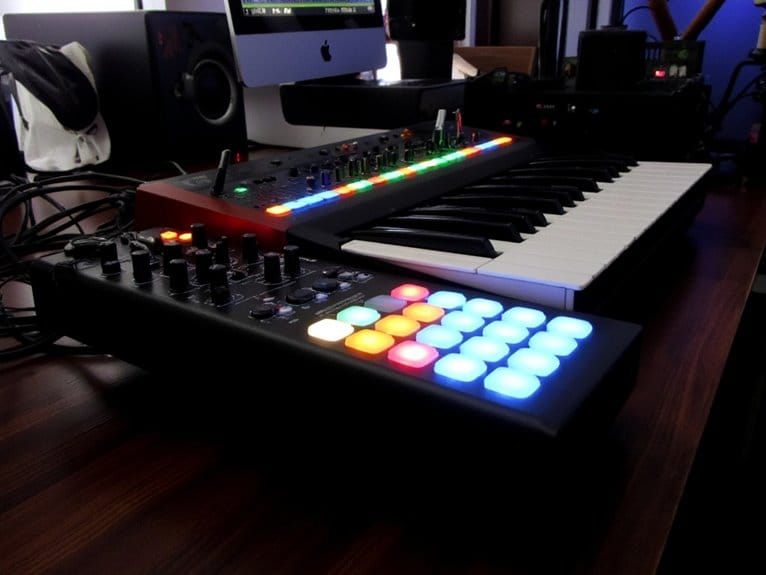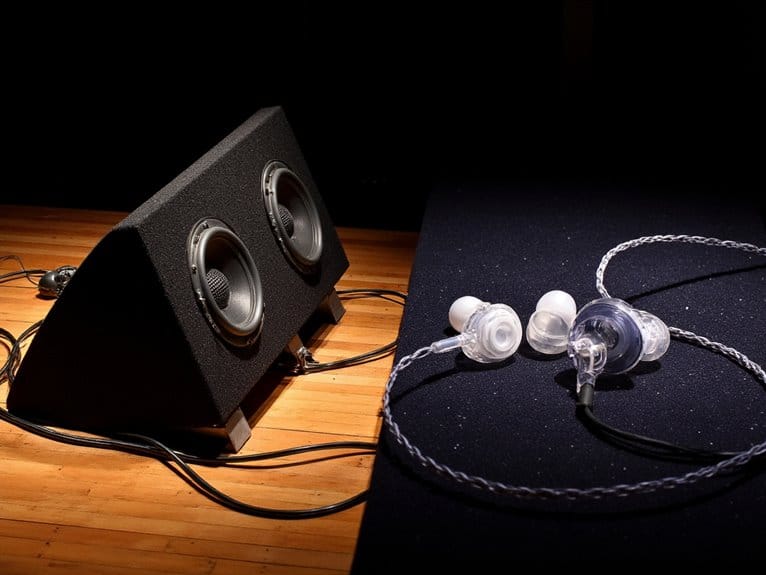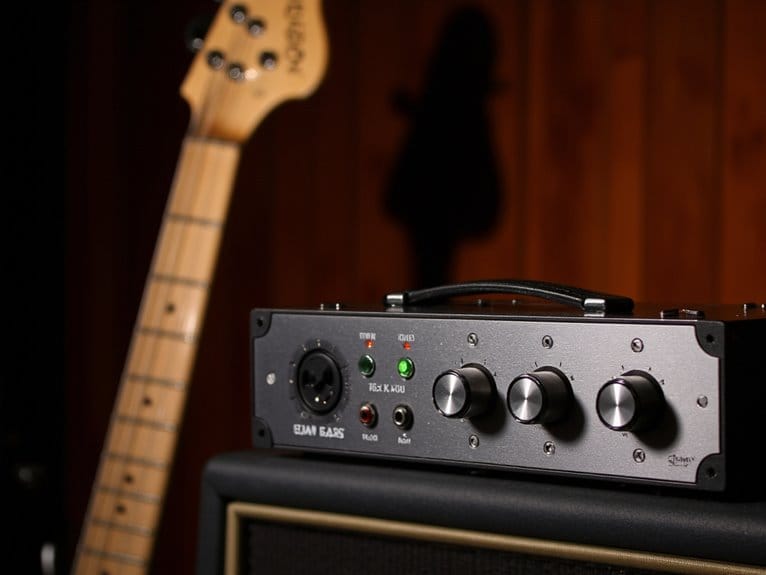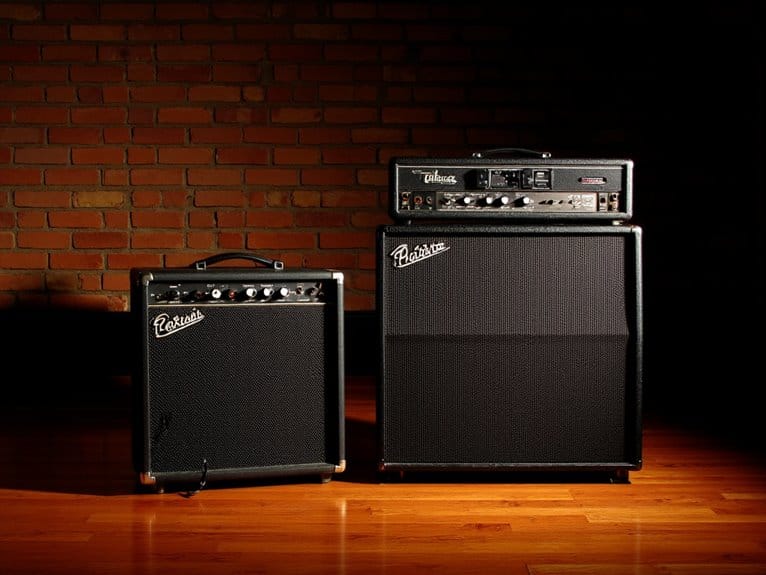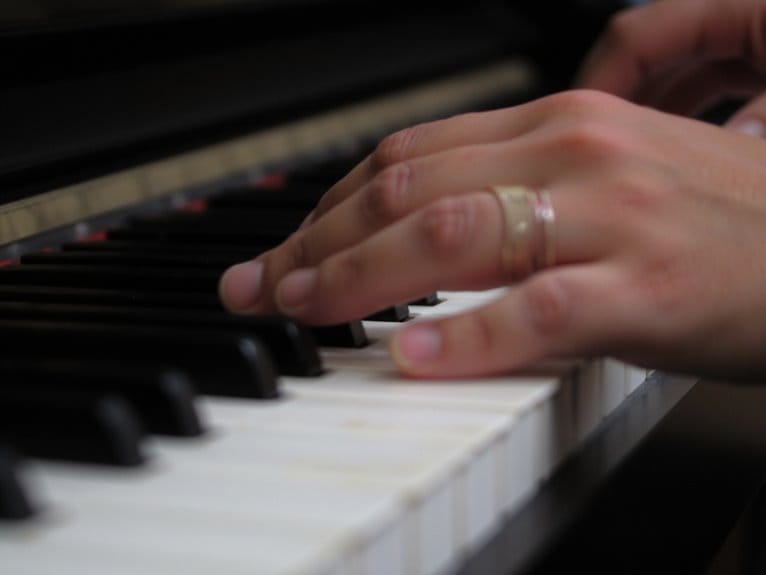Understanding MIDI Channels and How They Work
MIDI channels function as dedicated communication highways that let you control up to 16 different instruments simultaneously without messages getting tangled, much like radio stations broadcasting on separate frequencies. Each device you connect listens only to its assigned channel, preventing your drum machine from accidentally triggering when you’re playing piano melodies, while your sequencer routes distinct musical parts to specific synthesizers. This organizational system becomes essential when you’re managing complex multi-instrument setups, and there’s much more to explore about maximizing these pathways.
We are supported by our audience. When you purchase through links on our site, we may earn an affiliate commission, at no extra cost for you. Learn more.
Notable Insights
- MIDI channels are 16 distinct communication paths that allow multiple synthesizers to receive specific commands without interference.
- Each device can be assigned to listen on specific channels, preventing message conflicts in multi-instrument setups.
- The 16-channel standard was established in 1983, balancing flexibility with processing power at 31,250 bits per second transmission.
- Channel filtering enables precise routing where devices respond only to messages on their assigned channels for orchestral arrangements.
- Additional MIDI ports and virtual routing software can expand beyond 16 channels for more complex musical arrangements.
What Are MIDI Channels and Why Do They Matter?
Communication—that’s what MIDI channels are fundamentally about, and if you’ve ever wondered how your keyboard can control multiple synthesizers without them all playing the same notes simultaneously, you’re looking at the genius of this simple yet powerful system.
Think of MIDI channels as distinct communication paths, similar to how radio stations broadcast on different frequencies, allowing your devices to receive only the messages intended for them.
MIDI channels work like radio frequencies—each device tunes in to receive only the musical messages meant for it.
With 16 available channels per MIDI connection, you can layer instruments, trigger drum machines, and control effects processors independently, creating complex arrangements that would otherwise require multiple controllers. This system enables real-time response between devices, ensuring that your musical actions are transmitted instantly across your entire setup.
MIDI operates through 8-bit serial transmission at a specific data rate, providing reliable communication between your connected instruments and controllers.
Understanding MIDI channel types and exploring various MIDI configuration options transforms your setup from a basic keyboard connection into a sophisticated, multi-instrument powerhouse that responds precisely to your creative intentions.
How MIDI Channels Enable Device Communication
When you’re setting up multiple MIDI devices, channels become the essential traffic control system that determines which commands reach which instruments, preventing your drum machine from accidentally triggering your synthesizer’s bass sounds.
Through careful channel assignment and routing, you can send distinct data streams from a single controller to multiple devices simultaneously, with each instrument responding only to messages on its designated channel number.
This controller-to-instrument matching system transforms what could be chaotic signal overlap into organized, precise communication pathways that let you build complex musical arrangements without unwanted interference. Modern MIDI controllers like the Novation Launchkey 49 MK4 excel at managing these channel assignments through their comprehensive DAW integration features. MIDI provides 16 channels numbered 1-16 for this communication framework, giving you sufficient routing options for even elaborate multi-instrument setups.
Channel Assignment and Routing
Although MIDI’s fundamental architecture might seem straightforward at first glance, the channel assignment system represents one of its most powerful communication features, enabling up to sixteen distinct data streams to flow simultaneously through a single MIDI cable.
When you’re setting up your DAW, channel selection becomes vital for preventing message conflicts between multiple instruments or controllers. You’ll typically access these settings through your track inspector or output routing interface, where routing efficiency depends on proper channel assignments to guarantee commands reach their intended destinations.
Here’s what you need to know about effective channel assignment:
- Configure devices to listen on specific channels or “Any” channel for broader compatibility
- Use modifier keys like Shift+Alt to apply settings across multiple tracks simultaneously
- Implement channel filtering to reduce unnecessary message traffic and optimize processing
- Utilize “many-to-one” routing for layered instruments or “one-to-many” for parallel control
- Solo tracks to verify signal flow and confirm proper channel assignments in complex setups
Multi-Device Data Streams
The magic of MIDI channels becomes most apparent when you’re working with multiple devices, where each channel acts like a dedicated postal route that guarantees your musical messages reach exactly the right destination without getting lost in the shuffle.
Your synthesizer on channel 1 won’t accidentally play the drum parts meant for channel 10, while your bass module on channel 2 ignores everything except its designated messages.
This multi device synchronization works through message filtering, where each device listens selectively to its assigned channel while ignoring the other fifteen channels flowing through the same cable.
You’ll find this essential when building complex setups involving sequencers controlling multiple sound modules simultaneously, creating orchestral arrangements where every instrument responds precisely to its intended musical data.
Controller-to-Instrument Matching
Building on this foundation of dedicated data streams, I’ve found that matching controllers to specific instruments through channel assignment works much like programming a universal remote—you’re fundamentally telling each device which “frequency” to tune into so it responds only to commands meant for it.
This channel-based routing system guarantees superior controller compatibility while maximizing instrument responsiveness across complex setups:
- Split configurations let you control bass sounds on channels 1-3 while triggering lead synths on channels 4-8
- Layered arrangements stack multiple timbres from different modules using identical channel assignments
- Quick switching between instruments happens instantly by changing your controller’s transmit channel
- Multitimbral devices assign separate voices to different channels, creating entire orchestras from single units
- Independent control maintains separate drum, bass, and melody parts without signal interference
Whether you’re working with affordable synthesizers like the Korg Volca series or professional-grade equipment, proper MIDI channel assignment ensures seamless integration across your entire setup.
The Development and Technical Foundation of MIDI Channels
When you’re working with MIDI today, you’re benefiting from a standardization process that happened back in 1983, when industry leaders like Dave Smith and Ikutaro Kakehashi had to make some essential technical decisions about how electronic instruments would communicate.
They settled on a 16-channel design that I’d argue represents one of those perfect engineering compromises, providing enough channels for complex setups without overwhelming the limited processing power of early 1980s hardware or making the protocol unnecessarily complicated.
You can trace the success of this foundational choice through the immediate adoption by manufacturers like Sequential, Roland, and Yamaha, who recognized that this channel architecture would give musicians the flexibility they needed while keeping the technical implementation manageable.
MIDI Standardization in 1983
By January 1983, five major digital instrument manufacturers had gathered around conference tables with a shared vision that would fundamentally reshape how electronic music equipment communicated.
I can tell you that what emerged from those meetings wasn’t just another technical specification—it was the foundation for every MIDI channel you’ll encounter today.
Sequential Circuits, Roland, Yamaha, Korg, and Kawai didn’t just create midi history; they established the digital communication standard that remains virtually unchanged four decades later. The October 1983 MIDI 1.0 Specification defined those essential 16 channels per port that you’re using right now.
Here’s what made this standardization revolutionary:
- 31,250 bits per second transmission rate for reliable device communication
- Open licensing without patent fees encouraging universal adoption
- Hardware specifications including connectors and byte formats
- Voluntary agreements rather than formal legal requirements
- Global consensus across American and Japanese manufacturers
16-Channel Design Balance
Four critical engineering decisions shaped how MIDI channels deliver simultaneous musical independence, and I’ve spent considerable time analyzing why these particular choices created such an enduring foundation for electronic music communication.
The sixteen-channel architecture enables remarkable channel flexibility, allowing you to assign unique timbres to individual channels while maintaining complete separation between musical parts. This design facilitates sophisticated sound layering techniques, where multiple instruments can occupy different channels without interference.
Each channel operates like a dedicated radio frequency, filtering only relevant data while ignoring messages destined for other channels. The current loop hardware implementation, using 5 mA signals with opto-isolation, guarantees signal integrity across complex multi-instrument setups, preventing the grounding loops that plagued earlier electronic music systems.
Early Manufacturer Adoption
Three visionary engineers fundamentally transformed electronic music communication when Ikutaro Kakehashi, Dave Smith, and Tom Oberheim recognized that the industry’s fragmented landscape of proprietary protocols was stifling creative collaboration.
Their manufacturer collaboration began in 1981, establishing the foundation for what you’d recognize today as MIDI’s channel architecture.
Early device integration showcased MIDI’s practical benefits through these breakthrough moments:
- Sequential’s Prophet-600 launched in December 1982 as the first commercial MIDI-equipped synthesizer
- Roland’s Jupiter-6 followed in January 1983, proving cross-brand compatibility worked seamlessly
- The 1983 NAMM demonstration connected both instruments, transmitting channel data between competing manufacturers
- Yamaha’s DX7 adoption solidified MIDI as the universal standard by 1983
- Multiple manufacturers embraced the open protocol, abandoning their proprietary systems entirely
Modern MIDI implementations continue this legacy of cross-brand compatibility, with today’s audio interfaces maintaining seamless communication between Mac and Windows systems via standardized USB connections.
Real-World Applications in Music Production and Performance
When I first started exploring MIDI’s practical applications, I quickly realized that understanding channels becomes essential once you move beyond basic keyboard playing into serious production and performance scenarios.
You’ll find that different channels allow you to control multiple instruments simultaneously, whether you’re triggering drum samples on channel 10 while playing bass lines on channel 2.
The real time interaction capabilities shine during live performances, where you can switch between sounds instantly without missing a beat. This setup enables truly expressive performance opportunities, letting you manipulate pitch bends, modulation, and velocity across various instruments.
Modern DAWs utilize these channels for complex arrangements, while hardware sequencers rely on them for synchronizing multiple devices to maintain perfect timing throughout your productions.
For professional recording setups, connecting MIDI-enabled devices through audio interfaces like the Arturia MiniFuse 1 provides seamless MIDI connectivity that enhances your production workflow.
Working Around the 16-Channel Limitation
Despite MIDI’s remarkable versatility in production and performance environments, you’ll inevitably bump against its most persistent constraint: the 16-channel limit per port.
Fortunately, several MIDI porting strategies and virtual routing solutions can expand your creative horizons without sacrificing workflow efficiency.
Here are five proven approaches to overcome channel limitations:
- Multiple MIDI ports – Each additional port provides 16 fresh channels for complex arrangements.
- Virtual routing software – Tools like LoopBe create multiple virtual ports within your DAW environment.
- Hardware expansion options – Modern interfaces offer multiple outputs, multiplying your available channels.
- Audio channel archiving – Bounce finished MIDI tracks to audio, freeing channels for new parts.
- Multi port management – Organize instrument groups across separate ports to prevent channel conflicts.
These solutions require careful planning but dramatically expand your production capabilities.
Channel Modes and Message Types Explained
Once you’ve mastered the basics of MIDI channels, you’ll discover that understanding channel modes and message types transforms how your instruments respond to incoming data, giving you precise control over voice allocation and polyphonic behavior.
These channel modes determine whether your synthesizer operates in polyphonic response or monophonic efficiency, with omni functionality controlling whether instruments listen to all channels or just specific ones.
Channel modes give you the power to decide whether your synthesizer responds with full polyphonic richness or focused monophonic precision.
I’ve found that Control Change messages 120-127 manage these behaviors, letting you switch between modes dynamically during performance.
When you combine Omni Off with Mono settings, you get precise voice allocation where each channel handles one voice, perfect for multi-timbral setups requiring both chordal and lead sounds.
Frequently Asked Questions
Can I Use the Same MIDI Channel for Multiple Instruments Simultaneously?
Yes, you can use the same MIDI channel for multiple instruments simultaneously through MIDI routing. This creates instrument layering where all instruments receive identical messages, but you’ll lose individual control over each instrument’s parameters.
What Happens if I Accidentally Set Two Devices to the Same Channel?
You’ll get doubled sounds and control conflicts when both devices respond to identical MIDI data. For MIDI troubleshooting tips, check your device channel assignments immediately and reassign each instrument to separate channels.
Do Wireless MIDI Connections Support All 16 Channels Like Cable Connections?
Yes, wireless MIDI connections support all 16 channels just like cable connections. You’ll get full cable integration with no channel limitations – the wireless protocol doesn’t restrict MIDI channel functionality or messaging capabilities at all.
Can MIDI Channels Affect the Timing or Latency of My Setup?
MIDI channels themselves don’t cause latency issues. Your timing problems stem from buffer sizes, drivers, clock synchronization, and software settings. You’ll achieve better MIDI timing by optimizing these system-level factors rather than changing channel assignments.
Is It Possible to Change MIDI Channels While Playing Live Without Interruption?
Real time channel switching during live performance techniques isn’t directly supported on most hardware controllers. You’ll need software routing or patch changes instead of switching actual MIDI channels to avoid interrupting your performance flow.
On a final note
Now that you’ve explored MIDI channels, their technical foundations, and practical applications, you’ll find they’re essential for organizing complex musical setups. Whether you’re managing multiple instruments, routing messages efficiently, or working around the 16-channel limit, understanding these concepts will dramatically improve your workflow. I’ve seen countless producers transform their creative process once they master channel management, and you’ll likely experience similar breakthroughs in your own music production journey.

